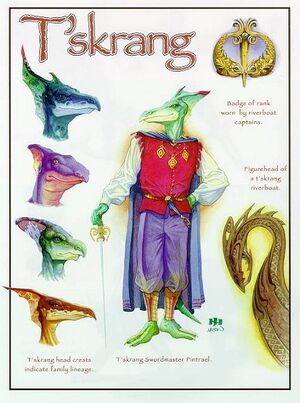T'skrang were a lizardman-like sentient race that existed during the Fourth World (Earthdawn). T'skrang were semi-aquatic, pseudosaurian, oviparous, male-nursing amphibians. T'skrangs in the Sixth World (Shadowrun) are only present in the Plane of Beasts, on the isle of Tandora, and are referred to as Tandorans.

Characteristics[]
Height averages about 5'9" (177 cm) and weight about 200 pounds (91 kg). Skin color is most often green, varying from yellow-green to dark forest green, but aqua blue and sunset red variants are also noted. They are often portrayed with crocodilian or pterodactyloid heads, with a cartilageineous crest, though source materials suggest that configurations analogous to other types of dinosaurs are possible. Hands are depicted with two, three, or four fingers, and feet sometimes with only two toes, while legs are shown as either humanoid or somewhat avian, depending on the artist.
T'Skrang in the 4th World[]
The general character of T'skrang is described as flamboyant, outgoing, talkative, and mercantile. The base social unit is the niall, which is analogous to a clan, and is headed by the lahala and the Council of Women. The lahala is usually the oldest woman in the niall, and she undergoes a renaming ceremony in which she takes only the Name of the niall (for example, Ilarsadin) as her own, and also receives all the memories and magical talents of previous lahalas. Most T'skrang settlements are composed of two to four nialls.
Reproduction (4th World)[]
Females give their eggs to the Council of Women, which bring them to near hatching in large vats of thin, warmed mud. When an egg is near to hatching, it is given to a trusted and honored male, and the pheromones it releases cause him to lactate and form a powerful emotional bond with the unhatched infant, similar to maternity. When the egg hatches, the male becomes the hatchling's chaida, or egg-parent, and he gives the hatchling its first personal Name, as well as the Name of the niall (for example, Makrod Ilarsadin). Hatchlings are sexless and each remains in its chaida's exclusive care until it is weaned. Starting at about age three, the duties of rearing, teaching, and training the hatchling becomes more widely dispersed throughout the niall, though primary responsibility for rearing the hatchling remains with its chaida. Because the rearing of children is divested from parentage and dispersed throughout the niall in this manner, marriage and fidelity are less important and less common in T'skrang society than in others.
Hatchlings reach full growth at age ten and sexual maturity between their twelfth and thirteenth birthdays. Developing gender and sexual maturity is a difficult process called kaissa, and many young t'skrang spend it as deck-scrubbers on t'skrang riverboats, and are assigned the most arduous chores. On his or her thirteenth birthday, the young t'skrang chooses a Name of his or her own, to go with the other two (for example, G'nithkar Makrod Ilarsadin).
Habitat (4th World)[]
T'skrang prefer to live in rivers, often submerging part or all of their homes, with sophisticated ventilation systems to keep the air fresh. The majority of t'skrang are involved in fishing, harvesting and crafting reeds, riverbed farming, and trade. T'skrang dominate river trade because they alone have riverboats powered by magical fire engines which combine True Air and True Fire for combustion. Many villages are able to maintain a riverboat, which is very important to trade, commerce, and the livelihood of the villagers.
T'skrang villages sometimes give allegiance to or collect into river confederations called aropagoi. Actual membership in an aropagoi is limited. Members add the name of the aropagoi to their own (for example, G'nithkar Makrod Ilarsadin Ishkarat). Aropagoi regulate, control, and tax river commerce along the stretches of river they claim as their own. Each of the aropagoi is led by a shivalahala. Like a niall's lahala, she retains the memories and magical Talents of her predecessors. Members of an aropagoi and the token they carry which indicates membership are both called g'doinya.
Language (4th World)[]
T'skrang language may be imagined to have construction somewhat like most depictions of elvish, with many long and mellifluous words, though including far more gutturals, glottal stops, and contractions.
Tandorans (6th World)[]
The Tandorans appear to be survivors of the 5th world's magical recession, brought to the Plane of Beasts by an unnamed great dragon known as the "Great Mother". The Tandorans do not have any reference to their 4th world existence. However, they retain many of the same environmental and cultural traits that the T'Skrang were known for.
The Tandorans operate river boats, and appear to function at an early technological stage of medieval weaponry and tribal living. They maintain a flamboyant, talkative culture that prides itself on one-up-manship and story telling. They practice gender fluidity through magical rituals to affirm their gender, sometimes on a daily basis to shift between genders that have advantage in the matriarchal culture.
Of note, a Japanese woman named Miko was transported to Tandora some time in the 1980s. Miko taught the Tandorans basic Japanese and about the late 5th world Japanese culture. The Tandorans saw her arrival as the first sign of a prophecy about the return of the Great Mother, and potential return to 6th World Earth.
